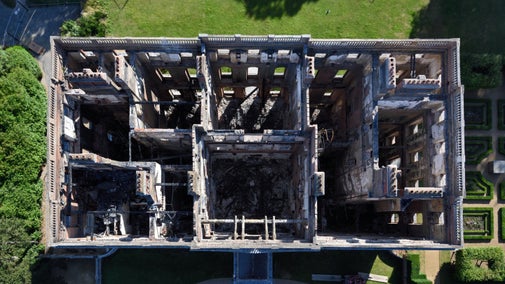
Discover more at Clandon Park
Find out when Clandon Park is open, how to get here, the things to see and do and more.

Clandon Park has many connections to Britain’s colonial activities across the world. Its colonial connection to New Zealand comes from William Hillier, 4th Earl of Onslow, who served as Governor from 1888-92. William bought a traditional Māori meeting house back to England as a memento of his time in New Zealand.
As the transatlantic slave trade was gradually ending, Britain’s colonial connections expanded to New Zealand.
This was one of the last habitable land masses in the world to be settled, but archaeological records suggest that the first East Polynesian migration occurred around 1250-1300 AD, many centuries before European colonisers arrived. The first was Dutch seafarer Abel Tasman in 1642, followed by British navigator James Cook over 125 years later.
In 1840 the British claimed sovereignty over New Zealand following the Treaty of Waitangi, a controversial agreement signed by Māori leaders and British representatives of the Crown which is still debated today.
There was a Māori language and English version of the treaty, which had different interpretations, leading to violent clashes over land and property between Māori groups and the British for several years after it was signed.
The British gradually imposed greater control so they could further expand into New Zealand. By then, the Onslow family of Clandon Park had been active in British politics for several centuries; three Onslow men were Speakers of the House of Commons and many had been MPs.
At this time it was becoming commonplace for aristocrats to take up roles within the British political system previously reserved for diplomats and military leaders.
In 1888 William Hillier, 4th Earl of Onslow, was appointed Under Secretary of State for the Colonies - a junior ministerial role based in the Colonial Office in London, overseeing the management of Britain’s colonies across the world.
He was only in this role for a year before he was appointed Governor of New Zealand, moving his whole family there to take up the post. They lived at Government House, an enormous residence in Wellington.
Most of the violent clashes between the British and the New Zealanders had passed by this point and William’s role was largely ceremonial. He was responsible for representing the Crown, projecting an image of royal gravitas and power.
The Governor was also the conduit for any communications between New Zealand and the British Colonial Office in London.
William and his young family participated in New Zealand life as an imperial presence within the colony. His second child, Victor Alexander Herbert Huia Onslow, was born in New Zealand in 1890 and given a Māori name.

Lord Onslow resigned from the role in 1892. He returned to England and resumed his parliamentary career in the House of Lords, becoming Parliamentary Under-secretary of State for India in 1895 and for the colonies in 1900.
When returning from New Zealand, he purchased a carved Māori meeting house called Hinemihi te Ao Tawhito (Hinemihi of the old world), as a memento of his time there.
Hinemihi had been an ancestor of the Ngāti Hinemihi tribe centuries ago, and the building was seen as a living embodiment of her spirit. Find out more about Hinemihi’s history here.
Collections were often brought back to Britain by colonial government officials who lived in or visited countries under British rule. They could be powerful tools in the British Empire, used to underline the differences between the English and ‘other’ cultures and to reinforce the British understanding of a hierarchy of civilisations.
Often such souvenirs were looted or stolen, but Hinemihi was paid for in an agreement with the leader of Ngāti Hinemihi. We do not know how freely this agreement was made, but Lord Onslow paid £50 (approximately £4,000 in today’s money) for Hinemihi and arranged for her to be brought from her original home in Te Wairoa back to England.
The carvings from the meeting house were transported to Clandon Park, where they were affixed to a new structure, made by estate staff. She is now used by the UK Māori community for ceremonial events and celebrations.

Find out when Clandon Park is open, how to get here, the things to see and do and more.
Discover the history of Hinemihi. Follow her journey from construction in New Zealand to the grounds of a stately home in Surrey.

Find out about plans to return Hinemihi, the 19th century Māori meeting house in the grounds at Clandon Park, to her ancestral home in New Zealand.

Read our report on colonialism and historic slavery in the places and collections we care for and discover how we’re changing the way we approach these issues.

Clandon Park's history spans more than three centuries, from its origins as a grand Georgian home to its time as a First World War military hospital and subsequent restoration in the 1960s.

The Onslow family first moved into Clandon Park in 1641 and since then there have been record-breaking politicians, First World War workers and pioneering women.

Curator Sophie Chessum witnessed the fire at Clandon Park first-hand. Read her account of the night of 29 April 2015.

Take a look at our timeline to find out what the team have been working on.